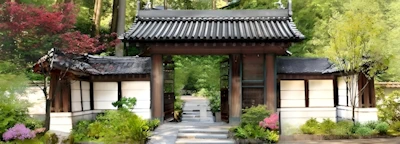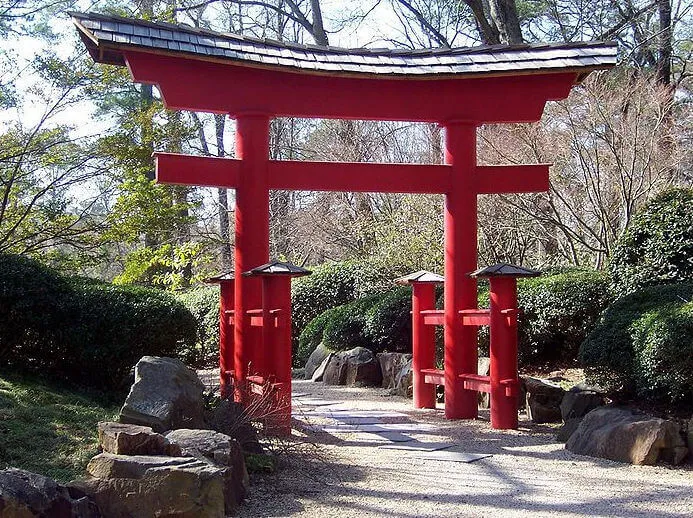Birmingham Botanical Gardens - Japanese Gardens
Event Location
Birmingham, AL 35223
Officially opened by the Japanese Ambassador to the United States in 1967, this 7.5-acre site is actually an interwoven collection of gardens built in the Japanese style, replete with traditional architectural and garden elements. Here you can find the tea garden, the karesansui garden with its meditative compositions of boulders set amidst a bed of raked gravel, the hill and stream garden* with features such as the Seven Virtues Waterfall, and the small stroll garden set around Long Life Lake. Casual visitors will want to study the colorful koi, relax in the lakeside rest shelter, peruse the bonsai house** or take a class at the pavilion. Plant lovers will enjoy exploring bamboo groves†, examining our growing collection of momiji - the Japanese maples and seeing prehistoric dawn redwoods and ginkgos.
Designed by Mr. Masaji “Buffy” Morai, the Japanese Gardens have been one of The Gardens’ most popular features since they opened. Largely through the hard work and guidance of volunteer Douglas Moore, major modifications to the upper section of these gardens were finalized in 1993 when the Japanese government named the area as an official Japanese Cultural Center. That important designation was made because Mr. Kazunori Tago, of Maebashi, Japan, one of the finest miyadaiku, or Japanese temple and shrine builders, created a traditional tea house here. Toshin-an, whose name means, “the house where those gathered can light a wick [of understanding] in each other’s hearts”, is a 16th-century Sukiya-style tea house, made completely from materials brought from Japan and built using only traditional tools and techniques. There are fewer than a dozen such structures in the United States, and none are finer than Toshinan††. An adjacent yoritsuki, or waiting hut, was also designed and built by Tago-san, completing the tea garden structures. Materials were donated by the citizens of Maibashi and additional funding was provided by the Shades Valley Council of Garden Clubs and Gardens of Inverness; the yoritsuki was dedicated in honor of Eva Woodin Gambrell. Members of the Japanese Garden Society of Alabama assist with maintenance of the tea house and partner with The Gardens in cultural and educational programming, along with the Japan-America Society of Alabama (JASA).
Delegations from Birmingham’s official Friendship City of Maebashi visit our Japanese Gardens every year or so, and especially to mark significant dates such as the 15th and 20th anniversary of Toshin-an, in 2008 and 2013, respectively. Shortly after the 15th, Mr. Tago presented a unique gift in memory of his good friend Douglas Moore, a traditional suikinkutsu, known as a “water cave” or “water harp.” Essentially a large, partially water-filled clay jar with a slotted lid, this feature is buried at the foot of the tsukubai (water basin) along the path to the tea house entrance. As water overflows the basin, it trickles through large stones and into the suikinkutsu, making subtle yet beautiful sounds. Visitors, who would traditionally be washing their hands prior to a tea ceremony, would be stooped down and only then would hear the faint subterranean music.
The Japanese Gardens are entered through a spectacular curved-top torii, or “gate to heaven,” painted a traditional bright orange-red. The original torii, part of the original construction in 1967, was replaced and made more substantial as part of a entrance renovation and master plan update in 1988 through funds given by the Drummond Company in memory of Elza Stewart Drummond. The current torii was renovated in 2007 by Dean Black, Springville, AL, and a time capsule installed in the nuki (the lower of the two horizontal pieces).
The entrance path is a gracefully sinuous tunnel of Yoshino cherries known as the Kayser Cherry Walk, given in 2013 in memory of Simmie Kayser by her family. The cherries include several propagated from the famous Yoshinos on the mall in Washington, DC, which were presented to The Gardens in 2012 by representatives from the office of the Consul General of Japan in Atlanta to mark the 100th anniversary of the original gift from the people of Japan. Further down the path, a tile-capped dobei (stucco) wall is punctuated by the entrance to the Japanese Cultural Center: the Taylor Gate, given by Dr. Wendell Taylor, with its heavy yet intricately joined wooden timbers. Mrs. Lamar Latimer (nee Taylor) funded a major renovation of the gate in 2011, with assistance from Friends of Birmingham Botanical Gardens through the Beeson Charitable Trust.
Across the stream from the tea house sits the Moore Japanese Cultural Pavilion, which is based on the design of a rural Japanese theater and was built in 1993. In 2011 it underwent a major renovation at the hands of Michael Moore, and was dedicated posthumously to his father Douglas Moore, its original designer and builder, in 2012. Three sides of the pavilion are removable, facilitating seasonal open air activities like classes such as sushi-making, performances such as martial arts demonstrations, and many other aspects of Japanese culture.
These activities are viewed from the Thorne Amphitheater, designed and built of Alabama sandstone slabs by ZEN Associates, Woburn, MA, in 2012. An interesting hybrid melding classic and Japanese design principles, this feature seats around 100 guests, and was funded by gifts from the estate of Barbara Drummond Thorne and daughter Beth Stukes.
The central watercourse (which along with its immediate surroundings is called the Hill & Stream Garden) consists of seven waterfalls and seven pools along its course, before it empties into Long Life Lake. This numeration is based on the seven virtues of bushido, the way of the samurai; these are benevolence, courage, honesty, honor, loyalty, rectitude and respect. Three wooden and two stone bridges allow water crossings. The arching Moon Bridge sits at the far end of Long Life Lake. The Bridge of Accomplishment, renovated in 2010 by Dean Black, Springville, AL, crosses over the lake. It symbolizes the twists and turns one must successfully navigate throughout life and is also called the “zig-zag bridge.” Cut-outs in the cedar panels are important Japanese cultural symbols including fans, cherry and chrysanthemum blossoms, and the leaves of bamboo and Japanese maple. The View-Receiving Bridge lies near the Moore Cultural Pavilion and is so-called because from this vantage point, all the structures in the Japanese Gardens can be glimpsed. The current configuration, designed and built by ZEN Associates replaced the much smaller original in 2011. It was funded by a gift from Mr. and Mrs. Lamar Latimer and Friends of Birmingham Botanical Gardens through the Beeson Charitable Trust.
Much of the recent work in this garden was called for in a 2007 renovation plan prepared by ZEN Associated. The firm’s principal landscape architects Shinichiro Abe and Peter White have an intimate knowledge of Japanese garden design and construction, and as their company’s name suggests, it is their sole specialty.
* This feature is currently non-operational.
** Please do not touch the trees. This area is monitored for security purposes.
† Closed during April and May to allow new growth.
†† Please enjoy at a distance. This area is monitored for security purposes.
Contact
Phone: (205) 414-3900
Location Website
Click to Visit
(For Event Information See Event Website Page)
Authentic Japanese Gardens (United States)
Best Japanese Gardens in the United States
Japanese Rock 'Zen' Gardens (United States)
Best Japanese Rock 'Zen' Gardens in the United States
Japanese Teahouses (United States)
Best Japanese Teahouses in the United States

















